Published
on 28
Oct 2004
|
All rights reserved.
|
|
|
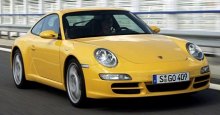 My
German boss told me "the other Porsches are not real Porsches". He
referred
to Boxster and Cayenne. "Only Nine-Eleven is the real Porsche". Yes, in
many people’s mind the name "Porsche" refers to a classic rear-engined
sports car with 6 horizontally-opposed cylinders and a flowing body
shape
headed by a pair of frog-eye headlamps. For the past 41 years it was
always
the icon of Porsche as well as German sports car industry. No one can
deny
that. My
German boss told me "the other Porsches are not real Porsches". He
referred
to Boxster and Cayenne. "Only Nine-Eleven is the real Porsche". Yes, in
many people’s mind the name "Porsche" refers to a classic rear-engined
sports car with 6 horizontally-opposed cylinders and a flowing body
shape
headed by a pair of frog-eye headlamps. For the past 41 years it was
always
the icon of Porsche as well as German sports car industry. No one can
deny
that.
911
is a miracle. Since Volkswagen Beetle died in 2003, it has been the
longest
surviving production car in the world. In the first 35 years of its
history,
the 911 evolved gradually. Some bigger steps were taken, such as type
964
in 1989 and type 993 in 1993, but they were also derived from the same
architecture dated back to the 1963 original. However, this
architecture
finally ran out of potential for improvement, so in 1998 Porsche
replaced
it with an essentially new design called 996. Everything was new except
the marketing name (still 911), the rear-mounted flat-6 formula and a
shape
evolved from the previous 911.
To
Porsche, replacing the original car with 996 was a big risk but it was
also a must. Luckily, the hard work paid off - sales increased and the
car was well received by fans, because the 996 simply outperformed 993
in every respect - speed, handling, refinement and space - while
retaining
most of the character of the old car. In the following 6 years, Porsche
introduced various derivatives of the 996 to broaden its appeal. It
became
the best selling 911 in history.
The
997 era
 Now
enter the 997 era. Despite of the new project number, 997 is actually
an
evolution from 996 rather than a big leap like the 964 or 993. This is
because Porsche considers the 996 architecture relatively young
(compare
to the original 911?) and foresees its ability for continuous
improvement
in the future. Now
enter the 997 era. Despite of the new project number, 997 is actually
an
evolution from 996 rather than a big leap like the 964 or 993. This is
because Porsche considers the 996 architecture relatively young
(compare
to the original 911?) and foresees its ability for continuous
improvement
in the future.
As
you can see from the photos, the 997 changed so little in proportion
and
styling. Apart from the slightly more muscular fenders and the return
to
classic round headlamps, the new 911 differs virtually nothing from its
predecessor, which is probably a good news to the fans of 911. The body
is widened by 38 mm, but length and height are almost untouched, as is
the 2350 mm wheelbase. Porsche claims all body panels bar the roof are
new and the aerodynamic drag coefficient is lowered from 0.30 to 0.28,
but you can clearly see underneath the clothes is the same steel
monocoque
chassis as its predecessor. However, the chassis is stiffened by 8%,
thanks
to better welding technology. Besides, wider tracks, upgraded
suspensions
(see next paragraph) and bigger brakes also enhance handling.
Suspension
is perhaps the biggest improved area of 997. On the one hand, it uses
softer
bushings and larger suspension travel to give better ride comfort and
NVH
isolation than the 996. On the other hand, it adopts Bilstein adaptive
dampers to improve body control. The so-called PASM (Porsche Active
Suspension
Management) system varies the stiffness of dampers continuously
according
to driving conditions. Besides, there is an integrated control system
linking
between PASM, engine management system and stability control. When the
driver select "Sport" mode, it will sharpen the throttle response,
stiffen
the dampers and raise the threshold of the stability control, much in
the
same way as Ferraris and BMW M-cars.
 In
the steering department, the 997 uses a new speed-sensitive variable
ratio
power steering to provide calmer response when cruising and sharper
response
when attacking corners. The Aisin-built 6-speed manual gearbox is also
new, offering shorter throw for crisper gearshift. In
the steering department, the 997 uses a new speed-sensitive variable
ratio
power steering to provide calmer response when cruising and sharper
response
when attacking corners. The Aisin-built 6-speed manual gearbox is also
new, offering shorter throw for crisper gearshift.
However,
all these modifications add weight. The standard Carrera now tips the
scale
at 1395 kg, 50 kg up from the last 996. At the same time, the 3.6-litre
boxer engine remains unchanged, although a revision to the engine
management
system boosts its output by 5 horsepower, now totaled 325 horsepower.
Maximum
torque stays at 273 lbft. Porsche still claims the same 0-60 time, but
we all know the new Carrera is going to be slower than its predecessor.
What's wrong with Weissach?
Apparently,
sooner or later Porsche must convert the 911's steel monocoque chassis
to aluminum one like what Ferrari did 5 years ago. This could save it
100
kilogram, benefiting acceleration, braking and handling. When Audi uses
this material to construct the A2, cost is no longer an excuse. The A8
and Jaguar XJ (to be followed by the new XK coupe as well) are priced
at
the same level as the Porsche sports car and produced at the same
yearly
rate. If they can switch to aluminum, why not the 911? Porsche should
consider
this seriously.
Carrera
S
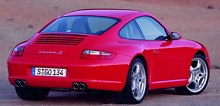 But
Weissach has not surrendered yet. In fact, the degrade of performance
in
the standard 911 Carrera is somewhat a marketing tactics. It leaves
space
for a more powerful Carrera S to slip in. For the first time since
1978,
Porsche is offering a higher performance S version alongside the
standard
911. The Carrera S has a bore-out, 3.8-litre version of the flat-six.
Like
the 3.6 version, it has a resonance-type variable induction manifold
and
VarioCam Plus system. The latter combines infinitely variable valve
timing
and 2-stage variable lift at the intake camshafts. The 3.8 engine pumps
out 355 horsepower and 295 lbft of torque, about 10% more than the
standard
Carrera to justify its 10% higher price. But
Weissach has not surrendered yet. In fact, the degrade of performance
in
the standard 911 Carrera is somewhat a marketing tactics. It leaves
space
for a more powerful Carrera S to slip in. For the first time since
1978,
Porsche is offering a higher performance S version alongside the
standard
911. The Carrera S has a bore-out, 3.8-litre version of the flat-six.
Like
the 3.6 version, it has a resonance-type variable induction manifold
and
VarioCam Plus system. The latter combines infinitely variable valve
timing
and 2-stage variable lift at the intake camshafts. The 3.8 engine pumps
out 355 horsepower and 295 lbft of torque, about 10% more than the
standard
Carrera to justify its 10% higher price.
Carrera
S also gets sportier chassis treatment. Its suspension is set stiffer
and
10 mm lower, riding on larger 19-inch wheels wearing wider / thinner
tires
and housing larger brakes. If not enough, you can pay extra for the
very
powerful and fade-free ceramic brakes too.
The
Carrera S has slightly higher drag coefficient (0.29) and it carries 25
more kilograms than the Carrera, but the extra 30 horsepower overwhelms
that. It takes just 4.6 seconds to storm from 0 to 60 mph, a little
over
10 seconds to 100 mph, bridging the gap between Carrera and GT3. Flat
out,
it will top 182 mph, a speed once reserved for Lamborghini Countach and
Ferrari Testarossa.
The
question is, why does Porsche need two Carreras? if you analyse the
customer
mix of 911, you will get the answer. 911 used to attract two very
different
kinds of customers - one is the so-called 911 hardcore fans whose first
priority is performance and handling, another is the majority customers
who just love the style and image of the Porsche icon while require
GT-style
comfort and refinement for daily use. By splitting the 911 into a
slower,
comfort-biased Carrera and a faster, sportier Carrera S, now the 911
can
satisfy the conflicting requirements of both parties!
On
the Road
996
used to be the most user-friendly sports car on the market. It offered
a lot of cabin room, useful luggage space (at the front as well as the
dog seats), supple ride and nicely weighted controls. But compare with
997 this is nothing. The new car takes comfort and refinement to a new
level, actually beating most Grand Tourers.
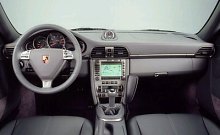 Even
in the sportier S model, it rides noticeably smoother than the 996,
easily
soaking up bumps that upset the old car. Never before had the 911 been
so comfortable. Even
in the sportier S model, it rides noticeably smoother than the 996,
easily
soaking up bumps that upset the old car. Never before had the 911 been
so comfortable.
The
cabin remains as roomy as before, but the driving position is improved
by a multi-adjustable steering wheel as well as a seat which can be set
20 mm closer to the floor. While the Cayenne-style center console is
not
very beautiful, materials and solidity are much improved. Admittedly,
this
is mostly due to the poor finishing of the 996 cabin. Style and
quality-wise,
it still fails to match an Audi TT which costs half the price.
However,
all controls are beautifully weighted: the clutch is lighter than
before;
the gearshift is much slicker, sweeter and quicker; the new
speed-sensitive
and variable ratio steering is lighter at low speed and eliminates
harshness
at straight-ahead. 911 has never been so relaxing to drive.
But
what we care most is excitement rather than comfort. In this aspect,
you
need the new Carrera S. Yes, the standard Carrera handles better than
the
old car, and its revised 3.6 engine feels slightly more responsive to
throttle
input, but the improvement is marginal while real world performance is
even slightly downgraded. In contrast, the Carrera S just does
everything
better by 10-15%. Its 3.8 engine is noticeably stronger from mid-range.
This is one of the best road car engines in the world, being flexible,
eager and characterful. Its power delivery is not exactly linear,
because
the operation of resonance induction manifold leads to a power kick at
5500 rpm, and then another kick at 6500 rpm. The result is even more
exciting
than a linear engine. And what a sound it makes! the metallic growl
produced
from the six horizontally opposed cylinders is unique in the world. It
is the trademark of 911.
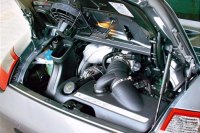 The
Carrera S has massive traction and grip from its 295/30ZR19 rear tires.
It can carry 10% higher speed into corners. Predictably, body control
is
first rate. Like the 996, "oversteer" is no longer an issue. The
suspension
setup and the choice of tire size successfully tame the machine which
carries
62% weight at the rear axle. To oversteer it needs heavy
provocation. The
Carrera S has massive traction and grip from its 295/30ZR19 rear tires.
It can carry 10% higher speed into corners. Predictably, body control
is
first rate. Like the 996, "oversteer" is no longer an issue. The
suspension
setup and the choice of tire size successfully tame the machine which
carries
62% weight at the rear axle. To oversteer it needs heavy
provocation.
Less
successful is the new power steering. Yes, it is more refined now, but
the drawback is a slower turn-in and slightly numb feeling at the
straight-ahead.
When you drive the 911 at low speed, the steering can feel uninspiring.
Nevertheless, the rack improves as you turn the wheel beyond 30°,
where
it becomes quicker, heavier and more communicative. The harder you
attack
corners, the better it feels.
That
said, 911 is still the best daily-use sports car in the world,
especially
the S version. Being simultaneously more comfortable and more exciting
to drive, it proves that Porsche’s philosophy of "continuous
improvement"
still works today. |
Verdict:      |
Published
on 25
Jun 2005
|
All rights reserved.
|
|
Carrera 4 and 4S
|
|
 Since
the era of 964 (that's 1989), Porsche has been offering the
4-wheel-drive 911 Carrera 4. The purist drivers always question the
need for 4WD. Because the rear-engined sports car has two-third of its
weight acted on the rear axle, the front wheel traction offered by 4WD
system is quite limited. On the other hand, the 4WD system added weight
and understeer, thus was disliked by most 911 fans. Since
the era of 964 (that's 1989), Porsche has been offering the
4-wheel-drive 911 Carrera 4. The purist drivers always question the
need for 4WD. Because the rear-engined sports car has two-third of its
weight acted on the rear axle, the front wheel traction offered by 4WD
system is quite limited. On the other hand, the 4WD system added weight
and understeer, thus was disliked by most 911 fans.
However, Carrera 4 was more popular in the United States, where 4WD
sport utilities are everywhere. That's why Porsche continues building
Carrera 4. In 993 and 996, the 4WD system was simplified to a viscous
coupling system weighing only 50 kg. This is carried over to 997
Carrera 4. Viscous
coupling uses multi-plate discs immersed in viscous liquid to
transfer torque. In normal condition, only 5% torque is sent to the
front wheels, maintaining the rear-drive character of 911. When the
rear wheels lose traction and spin, the speed difference between front
and rear axle will cause the viscous coupling to send more torque - up
to 40% - towards the front axle. As seen, this is a passive mechanism,
not as advanced as nowadays active differentials. Anyway, Porsche
complemented it with PSM stability control.
Apart from 4-wheel-drive, the new Carrera 4 also differs from Carrera
by employing a 44 mm wider rear fenders, just like the previous Carrera
4S and Turbo-look Carrera. This allows it to have wider rear tracks for
enhanced cornering stability and wider tires (295/35ZR18 instead of
265/40ZR18) for more grip.
On the other hand, the new Carrera 4S now becomes the combination of
Carrera 4 and Carrera S. In other words, it has the wide body, the 4WD
and the 355hp 3.8-litre engine. Its rear tires grow to 305/30ZR19.
Both cars are 55 kg heavier than the RWD versions. This take 0.1 second
off their 0-60 mph time, while the larger frontal area rob 3 mph from
their top speed. In real world, the difference is hardly perceptible.
Walter Rohrl even said the C4 are slightly quicker in Nurburgring
testing because of the wider tires and 4-wheel traction. However, the
C4 understeer more than the RWD car, and in tight corner it doesn't
slide its tail gently wide, making it slightly less engaging to drive.
|
Verdict:      |
Published
on 27
Sep 2006
|
All rights reserved.
|
|
Targa
|
|
 It
is difficult to define the word "Targa". In the beginning, Targa was
the 911 with a removable roof panel, something between coupe and
cabriolet. Since the 993, Targa has become the 911 with panoramic glass
roof. This concept was carried over to 996 Targa and the latest 997
Targa, so let me reuse the words in my 996 Targa report to describe the
roof: It
is difficult to define the word "Targa". In the beginning, Targa was
the 911 with a removable roof panel, something between coupe and
cabriolet. Since the 993, Targa has become the 911 with panoramic glass
roof. This concept was carried over to 996 Targa and the latest 997
Targa, so let me reuse the words in my 996 Targa report to describe the
roof:
"From the roof to the rear window is
completely a glasshouse, giving the cockpit a bright and airy ambience.
Press a button, the glass roof panel drops down a few centimeters and
then slide backward and underneath the rear window. This idea won’t
work in other cars, because only the 911’s swoopy roofline allows it.
With the roof opened, fresh air enters the cabin. Turbulence and wind
noise are well suppressed thanks to the wind deflectors popped up at
the leading edge of the roof. However, the existence of roof rails and
rear window still make a significant difference between the Targa and
the Cabriolet. There is still no substitution to a real cabriolet."
As before, the Targa roof of 997 is built by CTS (Car Top Systems),
formerly owned by Porsche and Mercedes. There are no significant
changes made, but CTS fine tuned the system to make it lighter (1.9kg
slashed from the glass to lower center of gravity) and better heat
insulation (it filters 83% infrared). The glass roof opens and closes
in 7 seconds whether the car is moving. The rear screen can now hinge
up like a liftback to access the luggage on the folded rear seats –
there are 230 liters there, making it the most user-friendly 911.
The 997 Targa is based on the wide-body Carrera 4 with 4-wheel-drive
and PASM stability control. Targa 4 is powered by Carrera's 3.6-liter
325hp engine, while Targa 4S employs Carrera S' 3.8-liter 355hp engine.
As the Targa conversion adds 60 kilograms to the equivalent C4, or 115
kilograms to the equivalent Carrera / Carrera S, performance is
slightly reduced.
Buy a 911 Targa and you must be prepared to accept some compromises in
handling. As glass is heavier than steel, the Targa has higher center
of gravity than the coupe. Moreover, its chassis rigidity is just half
of the coupe (although it is already 50 percent higher than cabriolet).
No wonder Porsche tuned its suspensions softer, emphasizing ride
quality and quietness rather than ultimate handling prowess and
precision. Use it as a touring car, the Targa is better than other
911s. Push it to the limit, it won't match a standard Carrera.
|
Verdict:     |
Published
on 22
Jun 2008
|
All rights reserved.
|
|
911 Carrera 2008 update
|
|
The
current 997 generation was born in 2004, so it is time for a mid-life
facelift and improvement. Externally, the new 997 continues Porsche's
tradition of evolutionary design. There are no big changes, only small
details differ from the old car, most notably are the enlarged front
intakes, new LED day time driving lights, new shape LED rear lights,
new door mirrors and wheel design. There is no obvious changes to the
dimensions and hard points position either. However, the base model
Carrera now looks almost the same as Carrera S (apart from twin-exhaust
against quad-exhaust), which explain why its coefficient of
aerodynamic drag increases from 0.28 to the same 0.29 as Carrera S.
Making the headline are two changes: direct
injection engine and PDK
double-clutch gearbox.
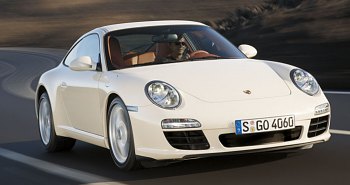 Carrera 3.6 (pictured) now shares
almost the same looks with Carrera S (blue car shown below)
Carrera 3.6 (pictured) now shares
almost the same looks with Carrera S (blue car shown below)
At
a time when
increasing engine capacity will inevitably draw criticisms from
politicians and heavy emission tax penalty, Porsche stops enlarging its
ever growing 6-cylinder boxer engine and, instead, seeks higher power
efficiency by means of direct fuel injection. So 911 adopts the first
direct injection system in Weissach. As you know, the cooling effect
from spraying gasoline directly into combustion chambers allows a
higher compression ratio to be adopted. So both the 3.6 and 3.8 engines
now run 12.5:1 compression. The result is more power and torque - the
3.6-liter engine of Carrera produces 345hp, 20hp more than before,
while the 3.8-liter engine in Carrera S produces 385hp, 30hp up. Other
modifications to the boxer engines are relatively minor, such as
revised bore
and stroke dimensions, lighter engine construction and reduced friction
of moving parts. In the end, the new engines return not only more power
but also considerably lower fuel consumption and carbon-dioxide
emission (see table below). Brilliant !
|
New Carrera 3.6 (6M)
|
New Carrera 3.6 (PDK) |
Old Carrera 3.6 (6M)
|
Top speed
|
180 mph
|
178 mph |
177 mph
|
0-60 mph
|
4.7 sec
|
4.5 sec |
4.8 sec
|
EU combined consumption
|
29.4 mpg
|
29.4 mpg |
25.6 mpg
|
CO2 emission
|
225 g/km
|
225 g/km |
266 g/km
|
|
New Carrera S 3.8 (6M)
|
New Carrera S 3.8 (PDK) |
Old Carrera S 3.8 (6M)
|
Top speed
|
188 mph
|
186 mph |
182 mph
|
0-60 mph
|
4.5 sec
|
4.3 sec |
4.6 sec
|
EU combined consumption
|
27.4 mpg
|
27.7 mpg |
24.6 mpg
|
CO2 emission
|
242 g/km
|
240 g/km |
277 g/km
|
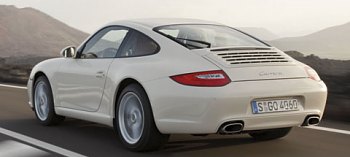 More powerful aside, the new engines
are also more frugal and environment friendly.
More powerful aside, the new engines
are also more frugal and environment friendly.
Another way to
enhance performance while reducing fuel and emission is to work on the
gearbox. After a long delay, ZF has finally completed a 7-speed
double-clutch gearbox for Porsche. Interestingly, Weissach tried to mislead us that
the box were developed in-house - on the one hand, it called the
gearbox as PDK, which stands for Porsche-Doppelkupplung. On the other hand,
its press release reminded us that it pioneered double-clutch
technology in 956 and 962 endurance race cars in the early 1980s.
Anyway, the 7-speed PDK is a big advancement not only compare to the
5-speed Tiptronic automatic transmission it replaces, but also to the
standard 6-speed manual gearbox still serving the new 911. Fast and
seamless gearshifts cut 0-60 mph by a further 0.2 seconds. However,
this improvement is not brought by the additional gear, because 7th is
actually an overdrive to enhance fuel economy in highway cruising. Top
speed is reached at 6th.
Relatively
light
changes have been made to the chassis. The springs, dampers and PASM
adaptive damping have been mildly retuned. Bigger brakes (330mm all
round) are adopted to Carrera.
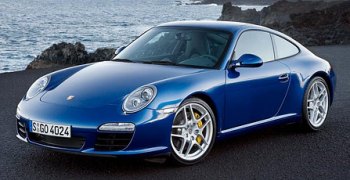 Porsche tried to mislead us that PDK
gearbox were engineered in-house...
Porsche tried to mislead us that PDK
gearbox were engineered in-house...
An optional "Sport Chrono
Plus" package has been introduced. It adds a
digital and analogue timer to the dash top for hardcore drivers to
measure lap time on racing circuit. Another important function it
brings is a launch control, which could cut another 0.2 seconds from
0-60 mph. Besides, the package provides a Sport mode button to set the
sharpest throttle response, heaviest steering, fastest PDK gearchange,
stiffest adaptive damping and higher threshold for the PSM stability
management system.
In the cabin, the environment is unchanged except some upgrades to
equipment, such as a LCD touch screen audio control system, Bluetooth
connectivity and USB / i-Pod ports.
On the
Road
The 911 Carrera has always been an all-round sports car - fast and
exciting to drive on the one hand, smooth and practical on the other
hand. This tradition is carried over to the 2008 update, albeit closer
again to perfection. Start the engine and you will sense it is smoother
and more willing than ever. The power is stronger throughout the rev
range, and cut-out is extended by 200 rpm to 7500 rpm. Exhaust noise of
European car gets quieter (unlike American car), but many drivers will
opt for sport exhaust anyway.
 Improvement to handling is not as
noticeable as the powertrain...
Improvement to handling is not as
noticeable as the powertrain...
The
6-speed manual gearbox is as
delicious to use as ever, but the new PDK box is even better. Its
gearshift is so seamless that nearly matches the old Tiptronic
torque-converter automatic, and so fast that no drivers can match it
with the manual box. This is definitely the biggest improvement of the
2008 update. No wonder Porsche's engineers forecast that it could
eventually replace the manual gearbox in a few year's time.
Nevertheless, the PDK is not without any flaws. Its biggest problem is
the driver interface - Porsche still insists to use buttons instead of
paddles to operate the gearshift (not to copy arch-rival Ferrari !),
which is not so handy. Worse still, the upshift and downshift buttons
are located on the front and back of the steering wheel respectively,
which is not very initiative to use.
The improvement to handling is not as noticeable as the powertrain.
Still, on the standard suspension the new 911 seems a little better in
suppressing its pitch and dive.
The keen throttle response, linear power delivery and uninterrupted
gearchange make the new Carrera S actually more fun to drive than 911
Turbo. It also delivers serious enough performance - Porsche recently
revealed that it lapped Nurburgring Nordschleife in 7 minutes and 50
seconds, some 12 seconds faster than the old car. It won't worry Nissan
GT-R, however. And this is what worries Porsche. While its marketing
people can rest on the laurel and say the 911 has a special status in
car lover's mind, I know the engineers at Weissach are working
relentlessly to strike back the fearsome GT-R, as they can't lose
anymore. While the 2008 update is another step towards perfection, the
really big progress should lie in the future 998.
|
Verdict:      |
Published
on 10
Dec 2009
|
All rights reserved.
|
|
911 Sport Classic
|
|
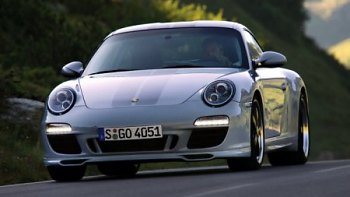 Exclusivity at a price
Exclusivity at a price
911 Sport
Classic is a special edition created by Porsche's Exclusive department.
Only 250 examples will be built to customers who demand something more
special than the regular 911s. How special ? Externally, the most
notable change is the "ducktail" rear spoiler
resembling the classic 2.7 RS, a double-bubble roof and those racing
strips paint work. There are also retro-looking wheels and interior
trim.
Mechanically, most things have been taken from the existing parts pool.
It
combines the wide-track bodyshell of Carrera 4S, whose rear fenders are
44 mm wider in total, with the rear-wheel
drive powertrain of Carrera S. The extra weight of bodyshell is offset
by adopting aluminum doors from GT3. The 3.8-liter direct-injection
engine has been tuned
to 408 horsepower (up 23hp) thanks to new exhaust, ECU and revision to
resonance intake manifolds. Torque figure is unchanged, but its
delivery is slightly broader. 6-speed manual gearbox is compulsory as
PDK is not deemed to be classic. The suspensions are dropped by
20mm to improve handling. Ceramic brakes and LSD are standard. Wider,
305/30ZR19 rear tires complete the package.
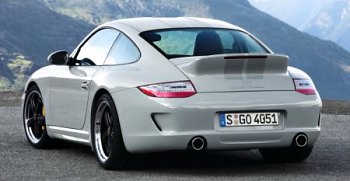 Ducktail spoiler resembles 2.7 RS...
Ducktail spoiler resembles 2.7 RS...
Astonishingly, all these set you back at
€170,000 or
£140,000, twice the price of the standard Carrera S ! For the
same money you can buy a small Lamborghini or Ferrari, an Aston
Martin V12 Vantage, or an Audi R8 V10 plus
a Catterham ! Who would want a duck-tail 911 that is
merely 0.1
second quicker to go from 0-60 than the standard Carrera S ? Who would
choose it over its faster and more talented siblings, i.e. the
£82,000 GT3 and £102,000 Turbo ?
Admittedly, the Sport Classic is charming in its own right. Its engine
is slightly more eager than Carrera S. Its ride far more supple than
GT3. Its engine, handling and controls are more honest than the Turbo.
Purists who want more comfort than GT3 may prefer this car to any other
911s. However, that alone cannot justify the absurd price. Exclusivity
is never cheap.
|
Verdict:     |
Published
on 17
Jan 2011
|
All rights reserved.
|
|
911
Carrera GTS
|
|
If not the price issue, we
would have preferred the special edition 911
Sport Classic over any other naturally aspirated 911s without the "GT3"
label. Thankfully, now all its merits can be found on the production
911 Carrera GTS. In particular, a wider and stiffer bodyshell based on
the Carrera 4, and a 408hp version of the 3.8-liter direct-injected
engine. Better still, this car costs only £2,000 more than
Carrera S, or just half the price of Sport Classic. Perhaps God has
listened to our prayer…
Having learned what SC is, you will not be a stranger to the GTS. Yes,
it does not sports the expensive PCCB brakes (as standard) and aluminum
doors as the SC, but it is still easily the sportiest Carrera of all.
The boxer engine gets a power kit which includes new exhaust and
resonance intake manifolds. The latter incorporates 6 switchable flaps
instead of the usual single butterfly to enhance mid-range torque and
high-end power. The result is not obvious at low rev, but once you spin
the engine past 6200 rpm, the intake system switches to another stage
and generates a really exciting roar, accompany with another 23
horsepower at 7300 rpm. Its top-end eagerness approaches the level of
GT3, although the quad exhaust does not generate as much noise.
Thanks to the lost of rear seats and use of lightweight single-bolt
wheels from Boxster Spyder, the GTS actually undercuts Carrera S by 5
kilograms. This help it to register slightly quicker acceleration.
The wider rear tracks and stiffer suspension setting also allow the GTS
to corner flatter, sharper and more neutral than Carrera S. Its
handling and ride quality bridges the gap between Carrera S and GT3. To
many people, the GTS is probably the best balanced package, satisfying
the need for excitement and comfort simultaneously.
Ultimately, it is not as fast or as thrilling to drive as GT3.
Moreover, with PASM suspension come standard, the GT3 is not
uncomfortable either. What makes the GTS appealing to most customers is
its more accessible price and the availability of many options, such as
PDK gearbox, Sport Chrono pack with launch control, rear seats and even
Cabriolet version. After all, it is a production car.
With the next generation 911 to arrive early next year, we expect the
GTS to be the final production version of 997 - there may be more
special editions, however. Incidental or not, Porsche also launched the
GTS version of 928 at the very last moment of its life. Like that car,
911 GTS will be remembered as the best of a kind.
|
Verdict:      |
|